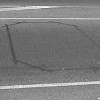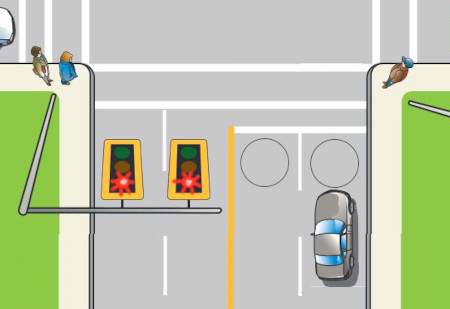 How about an article about the detection loops in the pavement at many traffic lights? Most drivers don't know what they are for and quite often stop too far ahead or behind them.
How about an article about the detection loops in the pavement at many traffic lights? Most drivers don't know what they are for and quite often stop too far ahead or behind them.
History
Once upon a time traffic signals operated on timers and would change according to the clock and not for any other reason. This could not reliably take into account the traffic flow changes that occur at different times of day and under different conditions. Advancements in technology has improved this, first with the inductive loop and now with the video camera. Each system has it's use.
Inductive Loops
The inductive loop is a coil of wire embedded in the pavement at the approach to a traffic signal. An electric current is passed through it creating a magnetic field. When a large object containing iron such as a car or truck is near the loop, the nature of the magnetic field changes and the signal controller can take notice of it. If the vehicle stays at the loop for a set period of time the controller will cycle the signal to give the waiting traffic priority.
The Problem With Loops
Problems occur when the vehicle does not stop over the loop. Too far ahead or too far back and the controller decides nothing is there and does not cycle the signals.

Unless the driver realizes and repositions the vehicle over the loop, they may wait a long time for a green signal. So, pay attention to the stop line when you can see it, and make your best estimation when ice and snow covers it up. This will position your properly if you cannot see the tar covered loops in the pavement surface.
Some loops may not recognize motorcycles and bicycles because they don't contain enough iron to disturb the magnetic field sufficiently.
Cyclists can make the traffic lights cycle by pushing the pedestrian signal button if one is present. For the motorcyclist, there are devices that attach to their vehicles that are designed to trigger the loop and cycle the signal.
Video Cameras
Traffic signals may be controlled by video cameras instead of inductive loops. The cameras are able to accurately detect the presence of motorcycles, cyclists and pedestrians and change the traffic lights appropriately.

A Detailed Video Explanation
This video by Road Guy Rob explains in detail how traffic signals are triggered today:
Some good information here on how pavement sensors - and pedestrian pushbuttons - work to trigger a green light for cars, and/or a 'Walk' symbol for pedestrians. This technology makes our roadways much more efficient, moving all traffic in accordance with demand.
Probably most pedestrians don't think about it much, but 'Walk' / 'Don't Walk' signals weren't ever created to help them cross the road; all they ever needed for this was to be facing a green light. So in fact, they were created to prevent them crossing the road, in order to allow some vehicles to turn whilst the light is still green. Incidentally, if you're wondering whether a given traffic light is controlled on a timer system or a demand system, and haven't definitely identified the loops in the road surface, the presence of pedestrian pushbuttons is the clue.
If the vehicle stays at the loop for a set period of time the controller will cycle the signal to give the waiting traffic priority.
In fact, traffic engineers will sometimes design sensors (such as for a protected left turn arrow) so that this cycle will only be triggered after two or three cars have driven into the left turn chute (achieved by placing the sensors ten or fifteen meters prior to the stop line, ignoring the initial vehicles that just pass over them - they can wait for the solid green phase to end when oncoming traffic is constant). Plus which, sensors can also detect when traffic has ceased to cross the sensors, thus triggering the next phase of traffic movement at that light.
Whether it's magnetic sensors in the roadway, or pushbuttons, any device like this can become defective over time; and it's not always practicable to send out a repair crew right away. But that big grey box on the corner that controls all this stuff can be opened up and reprogrammed to deliberately create a constant false demand for a light or signal in the interim; this only takes an engineer a few moments, and keeps everything functional, if less efficient. We've seen this in action recently during the Covid19 outbreak in many municipalities, where all of the pedestrian pushbuttons are activated 24/7; it's like there are a bunch of people on every corner, punching those buttons all the time. Typically, they will hang little signs on the posts advising pedestrians not to bother pushing the button activating the 'Walk' signal they want; it's gonna happen as soon as practicable.
Here's a thought, from a guy who has seen all of this technical growth during my driving lifetime (and endured the stupidity of timer controlled traffic lights changing to green for the cross-traffic in the middle of the night, even when there is no cross-traffic). I reckon that with the traffic light technology we use these days, it has become redundant to allow traffic to turn right (or left, into a one-way) on the solid red light. And the world (or at least, our part of it) would be a safer place if they changed the law to reflect modern times.
- Log in to post comments
"So in fact, they were created to prevent them crossing the road, in order to allow some vehicles to turn whilst the light is still green." This is a fairly cynical take. The main benefit of a pedestrian display at a signal is that the flashing amber hand ensures ample time for most pedestrians to finish crossing before a perpendicular green light is served. That was a major safety innovation that shouldn't be ignored. To achieve that it's inherent that the flow of pedestrians into the crosswalk needs to be cut off at some point.
- Log in to post comments
Nonsense.
The main benefit of a clear "Don't Walk" signal does that real well.
Firstly, you have to realize the reason for the creation of pedestrian signals. Because there was a time when they just stepped out anytime the traffic light was green. Pedestrian signals were created to STOP THEM so that turning traffic had its' turn to make the corner before the light turned amber. The RED HAND had the same significance as the red light does to drivers. (Drivers are one of the various groups of road users who are expected to share the road ... ).
The creation of the countdown system seems to mean you can walk anyway if you think you can get away with it. It's absurd!
To achieve that it's inherent that the flow of pedestrians into the crosswalk needs to be cut off at some point.
At some point? Like, when only a single vehicle (or two at most in a big intersection waiting to turn left) after all else has cleared?
Of course, the traffic engineers have overcome the problem by introducing advanced green arrow turns in many cases to delay pedestrian movement, which is a clever solution.
- Log in to post comments
You've repeated your assertion but you haven't backed it up. The truth is that there is little known about early pedestrian signals. The FHWA's site suggests the first ones may have been scrambles which is quite the opposite of the point you're arguing. https://www.fhwa.dot.gov/infrastructure/walk.cfm
Also nothing I said was about the countdowns. I was only talking about walk/don't walk. The countdowns have their pros and cons.
- Log in to post comments
The inductance loops in the road are metal detectors. There is nothing else to it. Any piece of metal will help something be detected. There is no reason to pay money for a fancy device.
Magnets won't work either. It's a metal detector, not a magnetometer. The only way a magnet will work is if it just so happens to also be a large piece of metal. You can typically get a piece of non-magnetic metal much cheaper.
- Log in to post comments
I've had numerous occasions while cycling where the light wouldn't change. Motorists will pull up behind me, but not close enough to trigger the light. I'll try to point out the loop in the pavement and encourage them to pull up closer, but they still don't seem to get it!
Cameras are better, but I'll make a point of turning my bicycle broadside across the lane to ensure that I'm "seen".
- Log in to post comments
Here in Vancouver, there's an interesting sensor overhead, designed to detect buses, at the intersection of West 71st eastbound at Oak.
It triggers a flashing green (just like a ped crossing, only there isn't one as it's only southbound on Oak) to turn red, so Bus drivers have a chance to stop all the traffic from plugging the intersection.
At the intersection of East 24th & Nanaimo, there's a pedestrian controlled light that the buses can trigger in their favour, even if there are no pedestrians around pushing buttons. Not sure what makes that work!
- Log in to post comments
... I wonder how them there buses are able to get a white rectangle priority, when they're present?
- Log in to post comments
In almost every case it's simply that the busses have an approach lane with its own set of loops (or other detectors like a camera) that calls the transit phase.
Recently at the Metrotown station a more sophisticated approach was needed to call the transit phase where busses wait in mixed traffic. They developed a LiDAR approach specifically to do it. https://www.itscanada.ca/files/Burnaby%20ADBS%20System_brief.pdf
- Log in to post comments
- Log in to post comments

Taking leave of your sensors ...